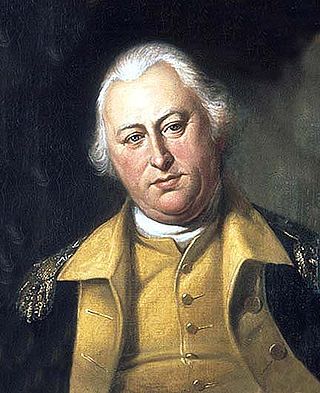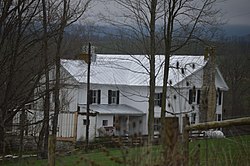
Benjamin Lincoln was an American army officer. He served as a major general in the Continental Army during the American Revolutionary War. Lincoln was involved in three major surrenders during the war: his participation in the Battles of Saratoga contributed to John Burgoyne's surrender of a British army, he oversaw the largest American surrender of the war at the 1780 siege of Charleston, and, as George Washington's second in command, he formally accepted the British surrender at Yorktown.

Andrew Lewis was an Irish-born American surveyor, military officer and politician. Born in County Donegal, he moved with his family to the British colony of Virginia at a young age. A colonel in the Virginia militia during the French and Indian War, and brigadier general in the American Revolutionary War, his most famous victory was the Battle of Point Pleasant in Dunmore's War in 1774, although he also drove Lord Dunmore's forces from Norfolk and Gwynn's Island in 1776. He also helped found Liberty Hall in 1776.

The Overmountain Men were American frontiersmen from west of the Blue Ridge Mountains which are the leading edge of the Appalachian Mountains, who took part in the American Revolutionary War. While they were present at multiple engagements in the war's southern campaign, they are best known for their role in the American victory at the Battle of Kings Mountain in 1780. The term "overmountain" arose because their settlements were west of, or "over", the Blue Ridge, which was the primary geographical boundary dividing several of the 13 American states from the Native American lands to the west. The Overmountain Men hailed from parts of Virginia, North Carolina, and what is now Tennessee and Kentucky.

Pennsylvania was the site of many key events associated with the American Revolution and American Revolutionary War. The city of Philadelphia, then capital of the Thirteen Colonies and the largest city in the colonies, was a gathering place for the Founding Fathers who discussed, debated, developed, and ultimately implemented many of the acts, including signing the Declaration of Independence, that inspired and launched the revolution and the quest for independence from the British Empire.

Richard Henderson was an American jurist, land speculator and politician who was best known for attempting to create the Transylvania Colony in frontier Kentucky. Henderson County and its seat Henderson, Kentucky are named for him. He also sold land to an early settlement that went on to become Nashville, Tennessee.

Andrew Beirne was an Irish immigrant who became a merchant, militia officer and politician in western Virginia, representing Monroe County in both houses of the Virginia General Assembly as well as the United States House of Representatives and the Virginia Constitutional Convention of 1829-1830.

The Maryland and Virginia Rifle Regiment, most commonly known as Rawlings' Regiment in period documents, was organized in June 1776 as a specialized light infantry unit of riflemen in the Continental Army during the American Revolutionary War. The American rifle units complemented the predominant, musket-equipped, line infantry forces of the war with their long-range marksmanship capability and were typically deployed with the line infantry as forward skirmishers and flanking elements. Scouting, escort, and outpost duties were also routine. The rifle units' battle formation was not nearly as structured as that of the line infantry units, which employed short-range massed firing in ordered linear formations. The riflemen could therefore respond with more adaptability to changing battle conditions.
Robert Lawson was an officer from Virginia in the American Revolutionary War.

James John Floyd (1750–1783) was an early settler of St. Matthews, Kentucky, and helped lay out Louisville. In Kentucky he served as a Colonel of the Kentucky Militia in which he participated in raids with George Rogers Clark and later became one of the first judges of Kentucky.

The 60th Virginia Infantry Regiment was an infantry regiment raised in Virginia for service in the Confederate States Army during the American Civil War. It fought mostly with the Army of Northern Virginia and in Tennessee.

Thomas Gaddis (1742–1834) was a militia officer in the American Revolutionary War. He was born December 28, 1742, in Winchester, Frederick County, Virginia and married Hannah Rice in 1764; the same year he built Fort Gaddis, a refuge from the Indians, located on the Catawba Trail. In fact, Pennsylvania and Virginia had conflicting claims in the area Gaddis settled. Though he maintained his loyalty to Virginia, Gaddis also protected his investment by recording his patent with Pennsylvania authorities. By 1773, both states created new geo-political boundaries in recognition of increased white settlement. Pennsylvania formed Westmoreland County out of the larger Bedford County, and Virginia established the District of West Augusta. In 1776, West Augusta was further divided into three counties: Ohio, Yohogania, and Monongalia, where Gaddis and his family resided.

Sampson Mathews was an American merchant, soldier, and legislator in the colony of Virginia.
The Mathews family is an American political family descended from John Mathews and Ann Archer, originating in colonial Virginia and active in Virginia and the American South in the 18th–20th centuries.
Archer Mathews was a United States pioneer, legislator, and city founder in the colony of Virginia. He was a member of the Virginia House of Delegates from Greenbrier County from 1780 to 1782.
Anthony Bledsoe was an American surveyor, politician and military colonel. He served in the French and Indian War and the American Revolutionary War.
Captain Mathew Arbuckle Sr., was a pioneering hunter and trapper of western Virginia and the Ohio territory. He is considered likely to have been the first white person to travel through Virginia all the way to the Ohio River, other than as a prisoner of the Indians. This trapping and trading trip may have occurred around 1764.
William Morris Jr. was a pioneer, military officer, and politician born in Orange County, Colony of Virginia. He served as a member of the Virginia House of Delegates for Kanawha County from 1792 until 1801 as a member of the Federalist Party. Morris served in Lord Dunmore's War in the Battle of Point Pleasant in 1774. He was wounded during the battle.














